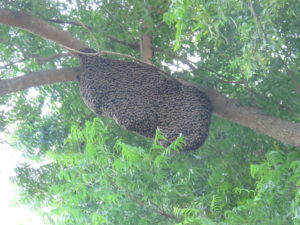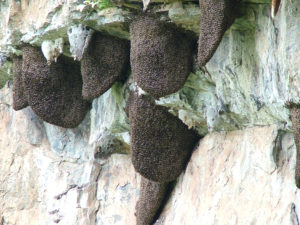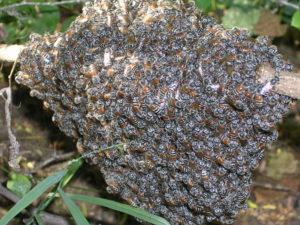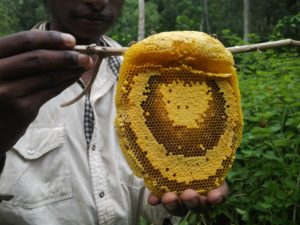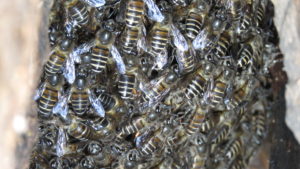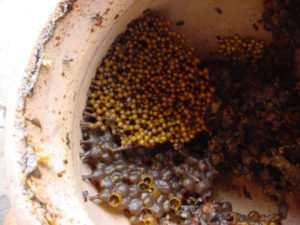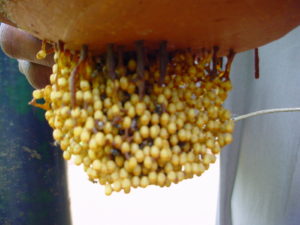The comb for each honeybee species is unique in structure and by the substrate that it is found on. Much of this has to do with the size of the bee and the kind of combs they create. In addition, nesting sites are very important factors for where the comb is built. It must not only be able to withstand the weight of a comb (especially for Apis dorsata) but also provide protection against adverse weather patterns or predators, and be decently close to a water/ food source.
Ideal nesting sites will be in somewhat open spaces while also being covered from wind disturbance. In addition, the combs will often be built on branches that face west and people believe it is because the bees prefer the evening light. In regards to the Giant Rock Bee, they prefer nesting sites on riverine trees in order to place their combs near a stream or river. When honey hunters of the Nilgiris notice that a tree has the proper qualities to be a nesting site then they will start clearing the undergrowth as well as small trees. This is to ensure that the qualified nest tree will be seen by the honeybees and that the clearing itself will be good circulation for the bees. A few common trees that are preferred for nesting include (Tamil name – botanical name – English name):
- Kadakai – Terminalia chebula – Black Myrobalan
- Llavu – Bombax malabaricum – Cotton Tree
- Tani – Terminalia bellirica – Bahera
- Vellamarda – Terminalia arjuna – Arjun Tree
- Maa – Mangifera indica – Mango Tree
Below are the specifics for each of the different honeybees species, their comb structure and typical nesting sites:
Apis dorsata
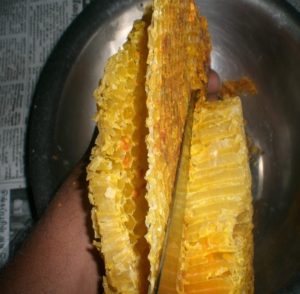
As the largest of the four Nilgiri honeybee species, the Giant Rock Bee builds hives that can sufficiently hold the large size of the colony, specifically with combs that can stretch 2 meters long and have a height of 1.5 meters. When combs are built on trees, the trees themselves have to be larger than average with thick branches to sustain against the weight. The honey section of the comb will be found at the top portion of comb that which is closest to the branch.
If a colony builds the hive on the underside of cliff then it will do so at a 45 degree angle, thus only half of the upper region of the comb will have honey. Given the massive girth of dorsata combs, the architecture of these hives must be quite sturdy. Thus, there is a section of the comb called the midrib that is built for the purpose of holding the heavy honey in the comb (hence it is not found at the brood section).
The midrib is thicker than 3mm and is made of plant resin, as well as wax that is secreted from the honeybees, and acts like a concrete material. The midrib has to be this stiff and strong because the honey cells are longer and comparatively bigger than the brood cells and thus give most of the weight to the comb.
Apis florea
Like the Giant Rock Bee, the Dwarf Honeybee or Little Honey Bee builds only a single comb per colony, however these combs are relatively smaller in size, measuring 15-16 cm in width with an indefinite height measurement. When the hives are constructed on the branch the honeycomb will be found on the top part of the branch and brood portion of the comb will be found at the bottom section. Thus, when honey is being gathered from a florea hive the brood part of the comb can go completely undisturbed. If there is honey at the bottom of the branch someone collecting honey simply has to tie a split bamboo to the branch, connect the brood to the bamboo, and then cut off the part of the branch with all the honey.
Apis cerana
The Asiatic Honey bee has a very unique comb structure and where it places its combs as compared to the other sister Apis species found in the Nilgiris. As opposed to a single comb it has multiple small combs that are lined parallel to one another. The outer hives are filled with honey while the inner hives are the brood section. Thus, this ensures that someone collecting honey can gather honey with out disturbing or destroying the inner brood section. In addition, these multiple comb hives are found exclusively within cavities, especially within tree hollows. Once a colony has built their combs within a tree cavity, they will return for years to come to the very same hollow. The size of the multi-comb hive depends entirely upon the cavity substrate it is built within. For instance, if a hive is built in a telephone pole then the combs will be long but if it is built in a barrel then the combs will be wide. Thus the size of cerana combs is indefinite.
Trigona (Dammer bees)
The smallest of the honeybee species in the Nilgiris it also constructs its hive that is smallest in size. The nests are built in the trunks of trees, logs, wall crevices, or under roof dwellings. It is very possible to hive this honeybee species, thus their combs can also be placed or found within substrates such as bamboo poles or clay pots. These honeybees often prefer narrow and lengthy cavities. As opposed to being a stiff ovular shaped hive, the combs of the Dammer bees take on a more globular shape with the various sacs lining whatever substrate (i.e. pot, log) they choose to nest in. Within the comb the large sacs store the pollen while the smaller sacs store the honey. Given the lumpy pod-like structure, there is no defined size of the hive.

